Did you know that eels are fish, too? These slimy snake-looking creatures look a lot different from your typical clownfish or guppy, but they are still considered fish. Eels can be freshwater or saltwater, ranging in size, color, and temperament. Some of these species have been introduced into the aquarium hobby and can make a fascinating addition to many fish tank setups.
Keep reading to find out about 8 eel species and how to care for them in your own freshwater or saltwater aquarium!
What are the different types of eels?
All eels belong to the Anguilliformes order, which contains about 800 different species. There are many different types of freshwater and saltwater eels in those categories but they are generally classified as elongated fish that lack pelvic and, most times, pectoral fins as well. These fish can grow anywhere from a few inches to over 10 feet (304.8 cm) in length. While freshwater eels mainly live in freshwater ecosystems, they do migrate back to saltwater for breeding.
Eels largely live in rockwork or near the substrate and are usually nocturnal, only emerging at night to feed. Some species live together while others live solitary lives. They are harvested for their meat in many countries and need to be prepared with care as their blood is toxic to humans. As we’ll see, they are also widely farmed and harvested for aquarium purposes as well.
What colors can eels be?
Because eels typically live on the bottom of their ecosystems, they are usually tones of yellow, greens, browns, and greys with a lighter underbelly. Some may be speckled while others might be striped; the especially ornate species tend to be the most popular within the aquarium hobby.
Types of freshwater eels
Freshwater eels belong to the Anguillidae family, which contains less than 20 total species. As mentioned before, even though these fish live the majority of their lives in freshwater, they migrate back to the ocean to spawn.
In the aquarium hobby, many fish are erroneously described as eels; you might see descriptions call these fish ‘eel-like’ as they do not truly belong to the Anguilliformes order and are usually a part of the Synbranchiformes order instead. Since these species are extremely popular in the aquarium hobby, we will include them in this article.
Freshwater moray eel (Gymnothorax polyuranodon)
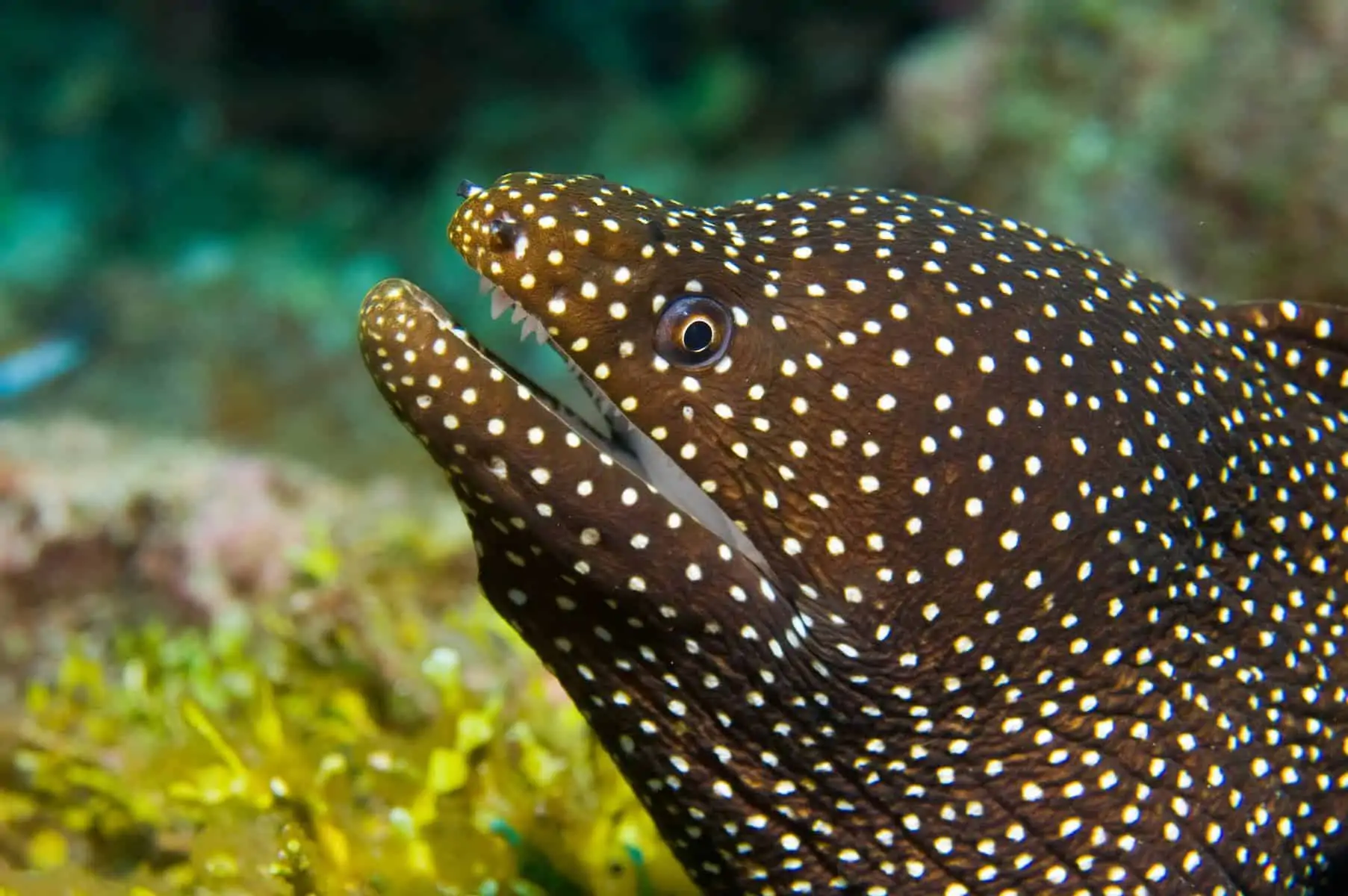
The freshwater moray eel (Gymnothorax polyuranodon), also sometimes known as the tiger moray eel, is one of the only true freshwater eels that is categorized under the Anguillidae family. However, while these fish can be found in freshwater settings, there is some debate as to if they do best long-term in freshwater water, brackish water, or a constant change between the two.
Some hobbyists find that their freshwater moray eel has the best colorations with brackish water and/or interchanged conditions; others have had no problems keeping their eels in fully freshwater parameters and have just as vibrant coloration.
While more research is needed, it is known that these eels can grow to be just under 5 feet (152.4 cm) in length. They are beautifully colored with black and yellow spots and lines and are native to the Indo-Pacific, namely around Indonesia and Australia. Freshwater moray eels need at least 100 gallons (378.5 L) and should be housed with passive fish that won’t nip at fins, but that also won’t be considered a snack!
Peacock eel (Macrognathus siamensis)
The peacock eel (Macrognathus siamensis), also known as the zebra spiny eel, is a very popular aquarium addition but is not a true eel at all! These fish are native to the Mekong, Chao Phraya, and Maeklong river systems throughout Southeast Asia, mainly throughout Thailand. They prefer slow-moving bodies of water where they can bury themselves into the substrate, waiting for when the sun goes down to forage for food.
In the home aquarium, these fish average 9 inches (23 cm) in length, but have the potential to grow to be a foot (30 cm) long. One peacock eel will need at least 40 gallons (151 L) and should be given a sand substrate with lots of hiding places. They do best with community fish that can’t easily be eaten, like rasboras, hatchetfish, rainbowfish, and swordtails.
Peacock eels need a constant water temperature between 73-79° F (23-26° C) with pH between 6.5-7.5.
Tire track eel (Mastacembelus armatus)
Tire track eels (Mastacembelus armatus), also called zig-zag eels, are another popular eel-like fish. They are widely found across Asia, from Pakistan to Vietnam and Indonesia, in freshwater rivers, streams, wetlands, and marshes. They are highly migratory, but can usually be found near the bottom of the substrate or buried in the sand.
If planning to keep one of these fish in your own aquarium, then they will need at least 125 gallons (473.2 L) as they can grow up to 3 feet (91.4 cm). Many hobbyists have adapted them to full freshwater conditions, though they can be kept in slightly brackish water conditions as well.
Tire track eels will do best with a soft substrate and secure structures that can’t easily be knocked over. They prefer tropical water temperatures between 72-82° F (22.2-27.8° C) and a relatively neutral pH between 6.8-7.2
Types of saltwater eels
It is much more common to see true eels from the Anguillidae family in saltwater ecosystems. The saltwater species of eel commonly seen in the aquarium hobby also tend to be much more colorful than freshwater ones, as they use those colors to blend in with the rockwork and sand of coral reefs.
Like freshwater eels, saltwater eels will also need a secure aquarium hood as they can be master escape artists.
Snowflake eel (Echidna nebulosa)
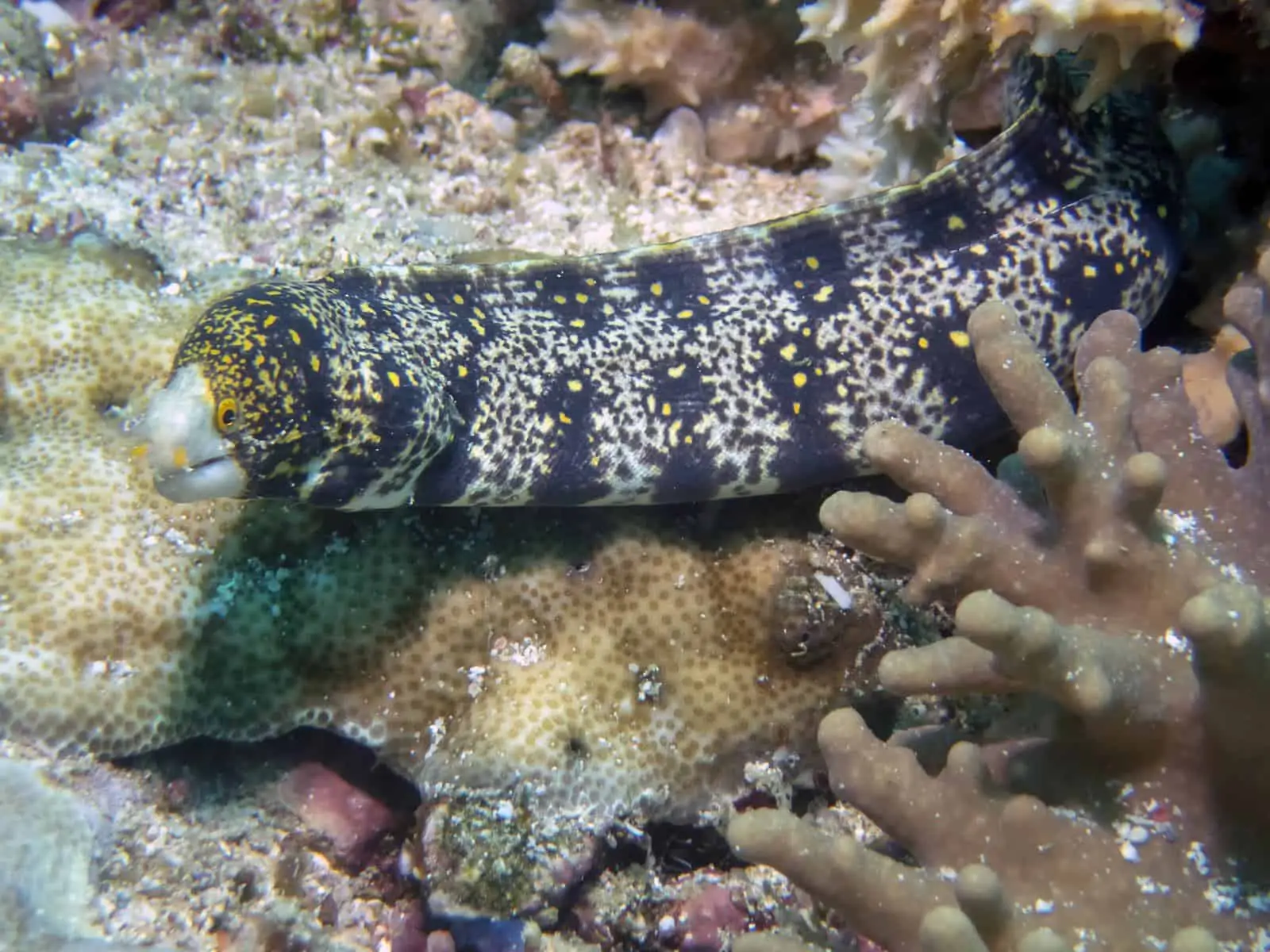
One of the most common saltwater eels you’re likely to come across is the snowflake eel, also known as the clouded moray eel and starry moray eel.
These marbled black, yellow, and cream-colored eels can be widely found throughout the Indo-Pacific, the Eastern Central Pacific, as well as the Southeast Atlantic. They can be found in shallow lagoons (<33 feet; <10 meters) as well as deeper coral reef structures and flats. Snowflake eels reach a maximum size of about 3 feet (91.4 cm), but usually, only grow to 2 feet (61.0 cm).
Snowflake eels are probably one of the most common eels to come across in the aquarium hobby and are often housed without proper care. These eels need 55 gallons (208.2 L) with even larger systems allowing for a more comfortable leeway for tank mates. They need lots of cracks and crevices to hide and do best on a sand substrate.
If you’re considering getting a snowflake eel, you cannot have any crustaceans or small fish in the tank; these eels naturally feed on shrimp, crabs, and other crustaceans in the wild, and that instinct will surely transfer into captivity! Instead, you may regularly feed your eel live, frozen, and freeze-dried seafood.
Zebra moray eel (Gymnomuraena zebra)
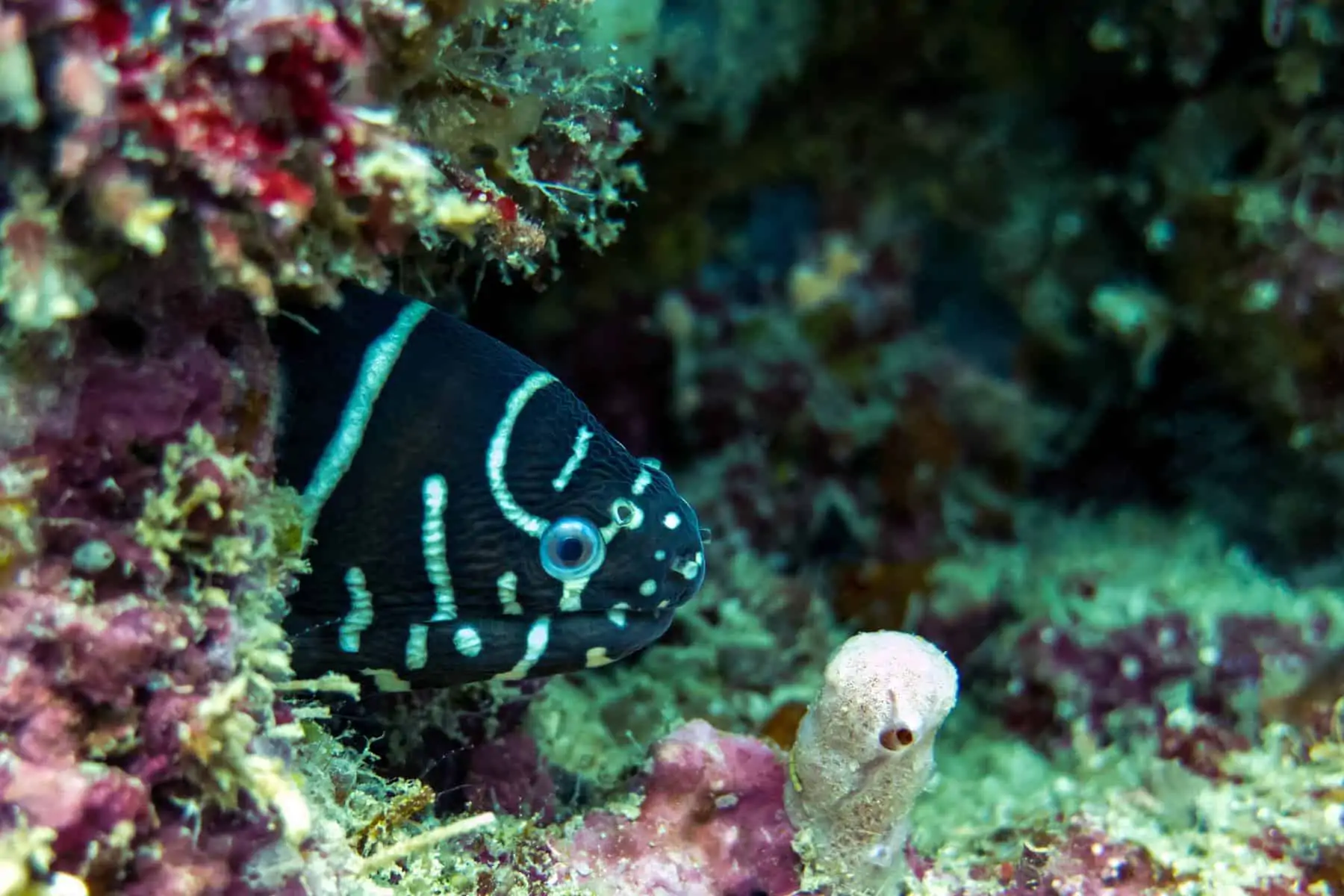
Possibly the second most common aquarium eel is the zebra moray eel (Gymnomuraena zebra) named for its obvious black and white alternating stripes. Another true eel, this species comes from the coral reefs of the Indo-Pacific and Eastern Central Pacific as well. There, they can grow up to 5 feet (152.4 cm) in length but are much more likely to only reach 2 feet (61.0 cm) in captivity.
These eels are relatively active in the tank and will even emerge from their hiding spots quite often throughout the day. While some hobbyists feel comfortable only having a 55 gallon (208.2 L) species-only tank, we recommend at least a 125 gallon (473.2 L) system in order to have a natural reef setting. They need a constant water temperature between 72-78° F (22.2-25.6° C), pH between 8.1-8.4, salinity between 1.022-1.025, and dKH between 8-12.
Most hobbyists find that zebra moray eels are less likely to eat smaller fish than snowflake eels, but are still not considered safe with crustaceans. It is best to give a meaty diet filled with live, frozen, and freeze-dried mollusks, crustaceans, and fish.
Tessalata moray eel (Gymnothorax favagineus)
The tessalata moray eel (Gymnothorax favagineus), also known as the laced eel, leopard moray eel, or honeycomb moray eel, is a beautifully speckled black, yellow, and cream-colored eel; these eels tend to resemble snowflake eels at first glance, but their black spots are solid on a yellow-ish cream background.
These eels have a more limited range than the previous saltwater eels, and can mostly be found along the eastern coast of Africa as well as south of Japan and the Great Barrier Reef. In captivity, these eels usually reach 5-6 feet (152.4-182.9 cm) in length.
While these eels are an impressive size, hobbyists have been able to make them work in large systems that are at least 200 gallons (757.1 L); some sites suggest that 150-180 gallons (567.8-681.4 L) is the bare minimum, but you will find that even then, you will need to upgrade to a larger aquarium. As with all eels, they will need secure rockwork.
In the wild, these eels like to eat smaller fish and cephalopods, like squid and octopus. It is best to avoid keeping smaller fish with your eel and giving regular feedings of live, frozen, and freeze-dried fish and invertebrates, with a special cephalopod snack every now and then.
Fimbriated moray eel (Gymnothorax fimbriatus)
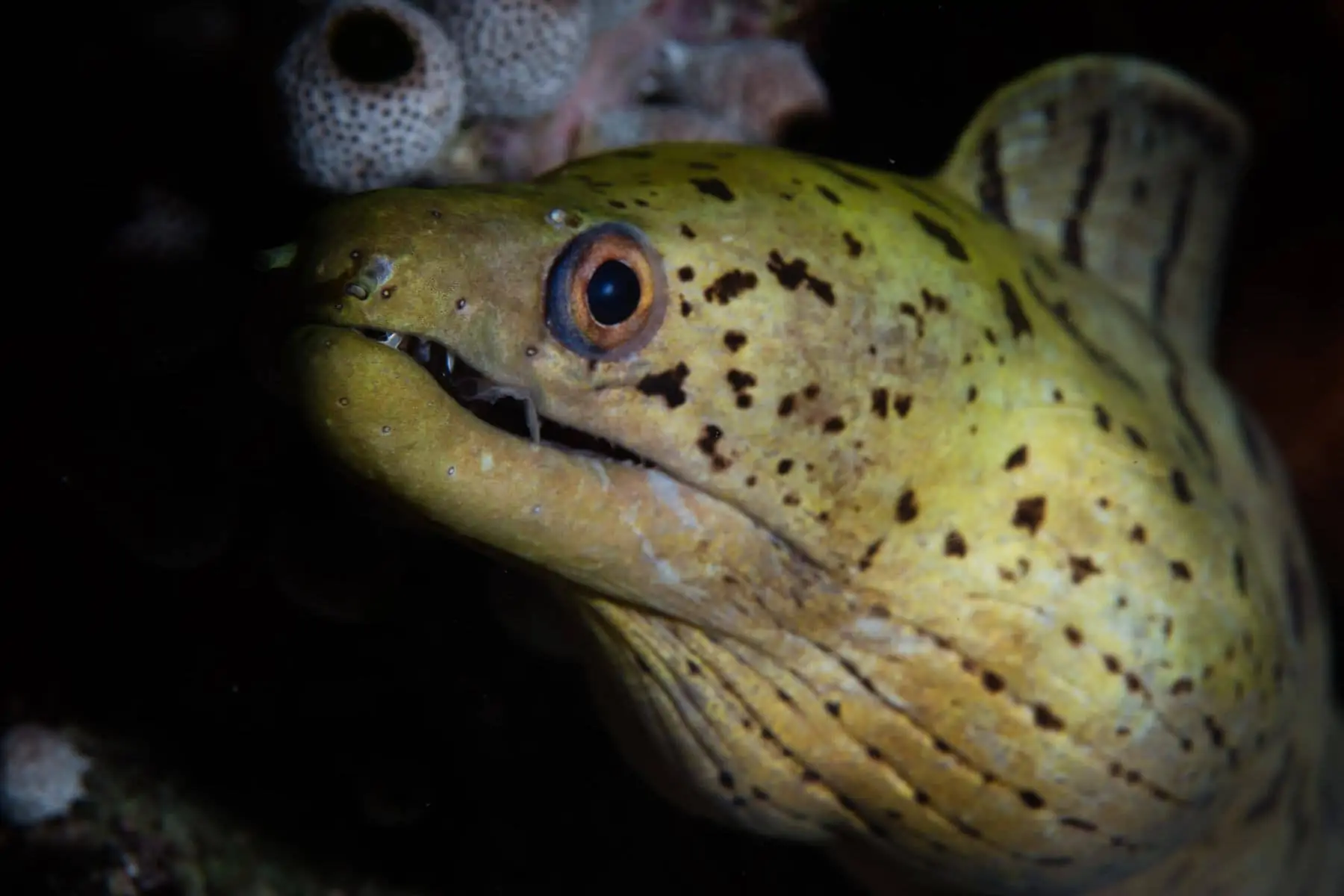
The fimbriated moray eel (Gymnothorax fimbriatus), or yellow-head moray eel, is one of the more aggressive eels available in the aquarium hobby. This Indo-Pacific species has an off-white body with brown patterning and a yellow-green head. It lives in the rockwork of coastal reefs but can also be found in brackish environments.
The fimbriated moray eel can grow to just under 3 feet (91.4 cm) as an adult and is a voracious predator. In the aquarium hobby, 90 gallons (340.7 L cm) should be enough to house a single eel; many sites recommend at least 50 gallons (189.3 L), but these eels will definitely appreciate lots of room to make their own and to hunt!
That being said, the fimbriated moray eel does tend to be more aggressive than the previous species listed. Eels have poor eyesight and a very strong bite and should never be handfed. Instead, these eels will need to be fed meatier foods, like live, frozen, and freeze-dried pieces of fish and various crustaceans with tongs.
Giant moray eel (Gymnothorax javanicus)
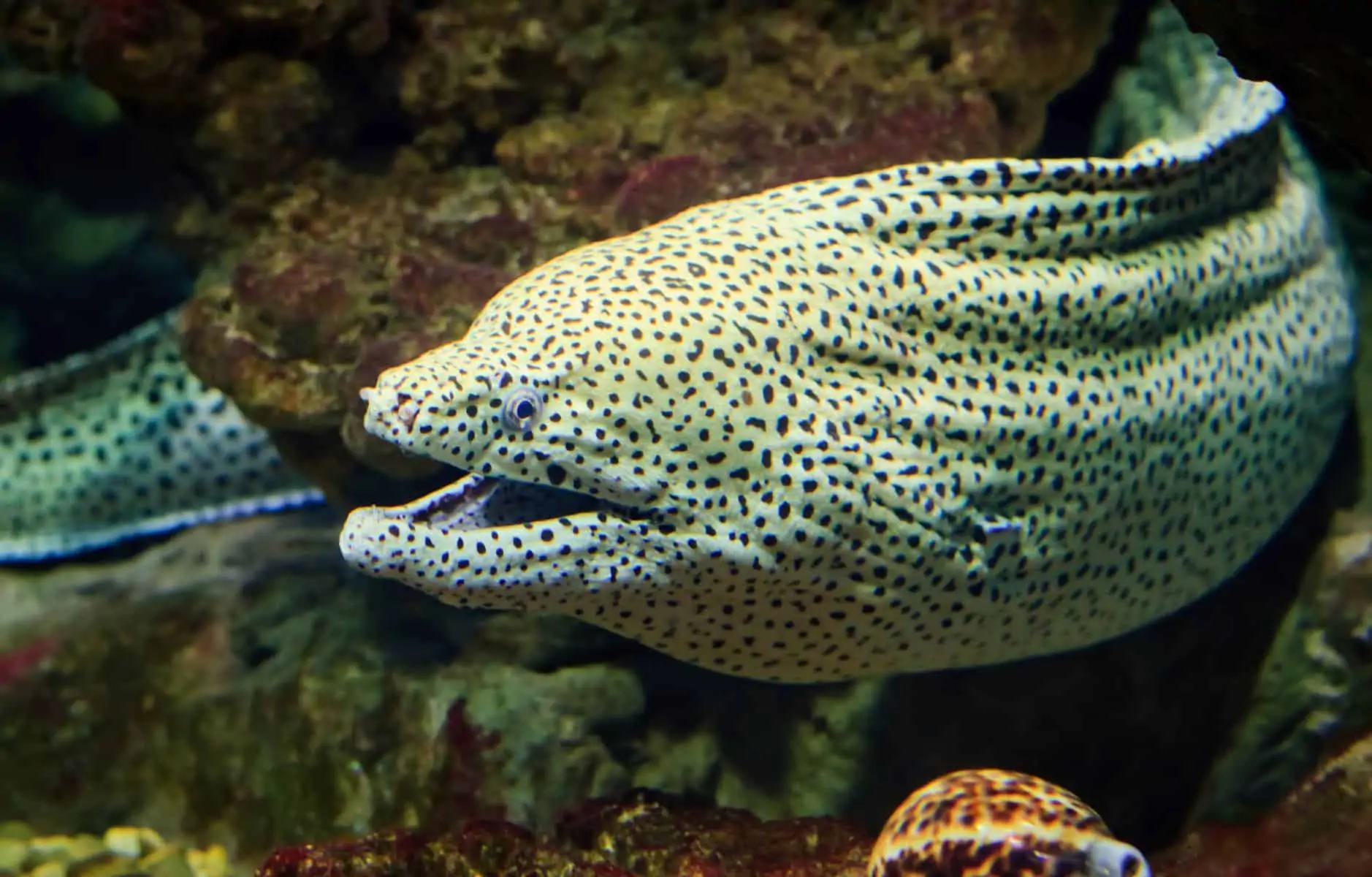
The giant moray eel (Gymnothorax javanicus) lives up to its name, reaching maximum lengths of 10 feet (304.8 cm). This species can only be found in public aquariums, but is definitely way too cool to not make this list of eels!
Giant moray eels are the largest species of eel from the Indo-Pacific and apex predators feeding on fish and larger invertebrates. They can usually be found near the drop-offs and slopes of tropical reefs.
What is the most dangerous type of eel?
All eels have the potential to be dangerous, whether it be through their bite or their toxins released when eaten. For true eels in the Anguilliformes order, the most fearsome will be larger moray eels, like the giant moray eel, which are very capable of biting off a finger if disturbed.
However, in terms of false eels, the electric eel (Electrophorus electricus) is probably the most notorious killer! These fish–that are actually more related to knifefish than true eels–can generate a shocking 800 volts of electricity which can quickly take down small animals and even full-grown humans.
Conclusion
Eels are some of the coolest creatures in the ocean and riverways, and hobbyists are eager to bring them into their home aquariums. However, not all hobbyists realize that most freshwater species labeled as eels aren’t truly related to their marine cousins. On the other hand, not many saltwater hobbyists understand how large these animals are truly capable of getting.
Before going out to buy your first eel, make sure that you have the correct tank size, a strong enough filter, and introduce tank mates based on your eel’s compatibility. Also, be prepared for having to feed meatier foods, which can become costly over time!
If you have any questions about these species of eels, other types of eels, or have had experience with an eel of your own, don’t hesitate to leave a comment below!

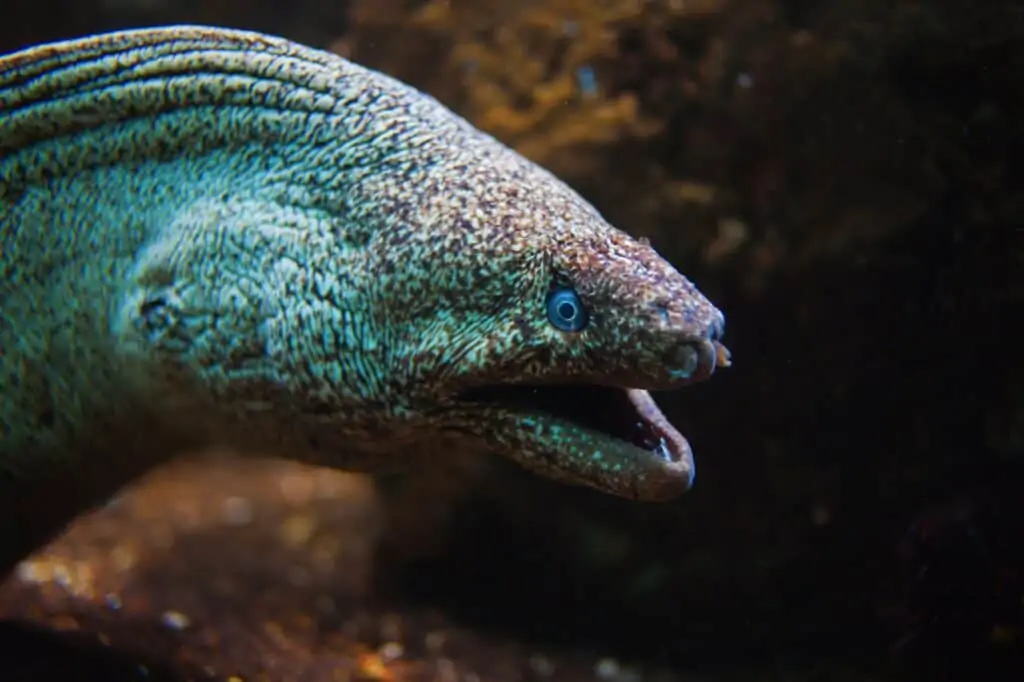

What about eels in the Eastern Caribbean? They are amazing too, I think listing has been done for the Pacific Ocean area.
Yup! There are many eels throughout the world. These are just some of the most commonly seen in the aquarium hobby.